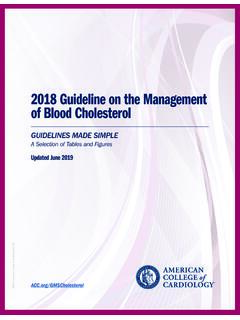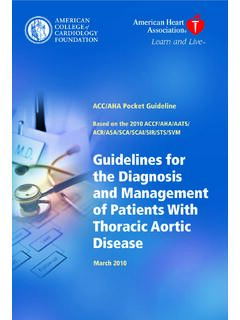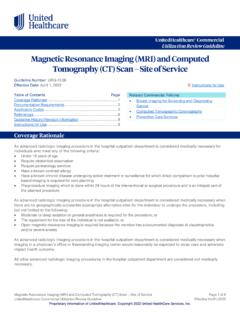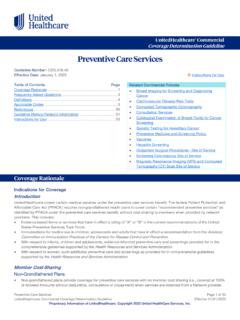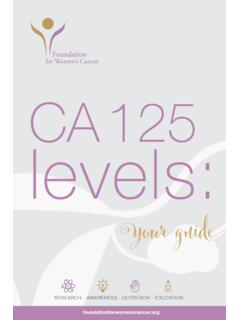Transcription of 2018 Guideline on the Evaluation and Management of ...
1 2018 Guideline on the Evaluation andManagement of Patients With Bradycardia and Cardiac Conduction DelayGUIDELINES MADE SIMPLE A Selection of Tables and Figures 2018, American College of Cardiology Guideline on the Evaluation and Management of Patients With Bradycardia and Cardiac Conduction DelayA Report of the American College of Cardiology/American Heart Association Task Force on Clinical Practice Guidelines, and the Heart Rhythm SocietyFred M. Kusumoto, MD, FACC, FAHA, FHRS, Chair Mark H. Schoenfeld, MD, FACC, FAHA, FHRS, Vice Chair Coletta Barrett, RN, FAHAJ ames R. Edgerton, MD, FACC, FHRSK enneth A. Ellenbogen, MD, FACC, FAHA, FHRSM ichael R. Gold, MD, PhD, FACCNora F. Goldschlager, MD, FACC, FAHA, FHRSR obert M. Hamilton, MDJose A. Joglar, MD, FACC, FAHA, FHRSR obert J. Kim, MDRichard Lee, MD, MBAJ oseph E. Marine, MD, MBA, FACC, FHRSC hristopher J.
2 McLeod, MB, ChB, PhD, FACC, FAHA, FHRSK eith R. Oken, MD, FACCK risten K. Patton, MD, FACC, FAHA, FHRSCara N. Pellegrini, MD, FHRSK imberly A. Selzman, MD, MPH, FAC, FHRSA nnemarie Thompson, MDPaul D. Varosy, MD, FACC, FAHA, FHRSCITATION: J AM Coll Cardiol. Nov 2018; DOI: Committee:The purpose of this ACC/AHA/HRS Guideline is to provide guidance to clinicians for the Management of patients with bradycardia, or symptoms thought to be associated with bradycardia or cardiac conduction system disorders. Although background on the pathophysiology and epidemiology of bradycardia and cardiac conduction disorders is summarized, this Guideline is not intended to be an exhaustive following resource contains Figures and Tables from the 2018 Guideline on the Evaluation and Management of Patients With Bradycardia and Cardiac Conduction Delay.
3 The resource is only an excerpt from the Guideline and the full publication should be reviewed for more figures and tables as well as important context. Top Ten Take Home Messages ..4-5 Key Tables/Figures Organized by Take Home Messages General Table 3. Table of Definitions ..6-8 Figure 1. Evaluation of Bradycardia and Conduction Disease Algorithm ..9 Sinus node dysfunction definition Table 7. Common Potentially Reversible or Treatable Causes of Sinus Node Dysfunction .. 10 Figure 2. Initial Evaluation of Suspected or Documented Sinus Node Dysfunction Algorithm .. 11 Figure 5. Acute Pacing Algorithm .. 12 Figure 6. Chronic SND Management Algorithm .. 13 Nocturnal bradycardias and screening for sleep apnea Sleep Apnea Recommendations .. 14 Newly identified left bundle branch block Cardiac Imaging in Bradycardia or Conduction Disorders Recommendations.
4 15 Establishing temporal correlation between symptoms and bradycardia General Principles of Chronic Therapy/ Management of Bradycardia Due to Sinus Node Dysfunction Recommendations .. 16 Table 4. Medications that can Induce/Exacerbate Bradycardia or Conduction Disorders .. 17 Table 5. Conditions Associated with Bradycardia and Conduction Disorders .. 18 Figure 4. Acute Bradycardia Algorithm .. 19 AV block and pacing Figure 3. Initial Evaluation of Suspected AV Block Algorithm .. 20 Table 8. Acute Medical Management of Bradycardia due to Sinus Node Dysfunction or AV Block .. 21 Table 9. Etiology of Atrioventricular Block .. 22 Figure 7. Management of Bradycardia or Pauses due to Chronic AV Block Algorithm .. 23 Figure 8. Evaluation of Conduction Disorders Algorithm .. 24 Cardiac resynchronization therapy or His bundle pacing versus right ventricular pacing Figure 9.
5 Management of Conduction Disorders Algorithm .. 25 Post-procedure surveillance after transcatheter aortic valve replacement (TAVR) Recommendations for Transcatheter Aortic Valve Replacement (TAVR) .. 26 Shared decision making and patient centered care Recommendations for Shared Decision Making for Pacemaker Implantation in the Setting of Guideline -Based Indications for Bradycardia Pacing .. 27 Table of Contents Page2018 Guideline on the Evaluation and Management of Patients With Bradycardia and Cardiac Conduction DelayGUIDELINES MADE SIMPLE 2018 Guideline on the Evaluation and Management of Patients With Bradycardia and Cardiac Conduction DelayBrady4 Back to Table of ContentsTop 10 Take-Home Messages (1 of 2) Sinus node dysfunction is most often related to age-dependent progressive fibrosis of the sinus nodal tissue and surrounding atrial myocardium leading to abnormalities of sinus node and atrial impulse formation and propagation and will therefore result in various bradycardic or pause-related syndromes.
6 The presence of left bundle branch block on electrocardiogram markedly increases the likelihood of underlying structural heart disease and of diagnosing left ventricular systolic dysfunction. Echocardiography is usually the most appropriate initial screening test for structural heart disease, including left ventricular systolic dysfunction. Both sleep disorders of breathing and nocturnal bradycardias are relatively common, and treatment of sleep apnea not only reduces the frequency of these arrhythmias but also may offer cardiovascular benefits. The presence of nocturnal bradycardias should prompt consideration for screening for sleep apnea, beginning with solicitation of suspicious symptoms. However, nocturnal bradycardia is not in itself an indication for permanent pacing. In patients with acquired second-degree Mobitz type II atrioventricular block, high-grade atrioventricular block, or third-degree atrioventricular block not caused by reversible or physiologic causes, permanent pacing is recommended regardless of symptoms.
7 For all other types of atrioventricular block, in the absence of conditions associated with progressive atrioventricular conduction abnormalities, permanent pacing should generally be considered only in the presence of symptoms that correlate with atrioventricular block. In sinus node dysfunction, there is no established minimum heart rate or pause duration where permanent pacing is recommended. Establishing temporal correlation between symptoms and bradycardia is important when determining whether permanent pacing is 3 2 5 4 Top Ten Messages is continued in the next MADE SIMPLE 2018 Guideline on the Evaluation and Management of Patients With Bradycardia and Cardiac Conduction DelayBrady5 Back to Table of ContentsTop 10 Take-Home Messages (2 of 2) In patients with a left ventricular ejection fraction between 36% to 50% and atrioventricular block, who have an indication for permanent pacing and are expected to require ventricular pacing >40% of the time, techniques that provide more physiologic ventricular activation ( , cardiac resynchronization therapy, His bundle pacing) are preferred to right ventricular pacing to prevent heart failure.
8 In patients with bradycardia who have indications for pacemaker implantation, shared decision-making and patient-centered care are endorsed and emphasized in this Guideline . Treatment decisions are based on the best available evidence and on the patient s goals of care and preferences. Because conduction system abnormalities are common after transcatheter aortic valve replacement, recommendations on postprocedure surveillance and pacemaker implantation are made in this Guideline . Identifying patient populations that will benefit the most from emerging pacing technologies ( , His bundle pacing, transcatheter leadless pacing systems) will require further investigation as these modalities are incorporated into clinical practice. Using the principles of shared decision-making and informed consent/refusal, patients with decision-making capacity or his/her legally defined surrogate has the right to refuse or request withdrawal of pacemaker therapy, even if the patient is pacemaker dependent, which should be considered palliative, end-of-life care, and not physician-assisted suicide.
9 However, any decision is complex, should involve all stakeholders, and will always be patient 87 10 9 GUIDELINES MADE SIMPLE 2018 Guideline on the Evaluation and Management of Patients With Bradycardia and Cardiac Conduction DelayBrady6 Back to Table of ContentsTerm Definition or DescriptionSinus Node Dysfunction (withaccompanying symptoms)AtrioventricularBlock Sinus bradycardia: Sinus rate <50 bpm. Ectopic atrial bradycardia: Atrial depolarization attributable to an atrial pacemaker other than the sinus node with a rate <50 bpm Sinoatrial exit block: Evidence that blocked conduction between the sinus node and adjacent atrial tissue is present. Multiple electrocardiographic manifestations including group beating of atrial depolarization and sinus pauses. Sinus pause: Sinus node depolarizes >3 s after the last atrial depolarization Sinus node arrest: No evidence of sinus node depolarization Tachycardia-bradycardia ( tachy-brady ) syndrome: Sinus bradycardia, ectopic atrial bradycardia, or sinus pause alternating with periods of abnormal atrial tachycardia, atrial utter, or AF.
10 The tachycardia may be associated with suppression of sinus node automaticity and a sinus pause of variable duration when the tachycardia terminates. Chronotropic Incompetence: Broadly defined as the inability of the heart to increase its rate commensurate with increased activity or demand, in many studies translates to failure to attain 80% of expected heart rate reserve during exercise. Isorhythmic dissociation: Atrial depolarization (from either the sinus node or ectopic atrial site) is slower than ventricular depolarization (from an atrioventricular nodal, His bundle, or ventricular site). First-degree atrioventricular block: P waves associated with 1:1 atrioventricular conduction and a PR interval >200 ms (this is more accurately de ned as atrioventricular delay because no P waves are blocked) Second-degree atrioventricular block: P waves with a constant rate (<100 bpm) where atrioventricular conduction is present but not 1:1 Mobitz type I: P waves with a constant rate (<100 bpm) with a periodic single nonconducted P wave associated with P waves before and after the nonconducted P wave with inconstant PR intervals Mobitz type II: P waves with a constant rate (< 100 bpm) with a periodic single nonconducted P wave associated with other P waves before and after the nonconducted P wave with constant PR intervals (excluding 2.)


